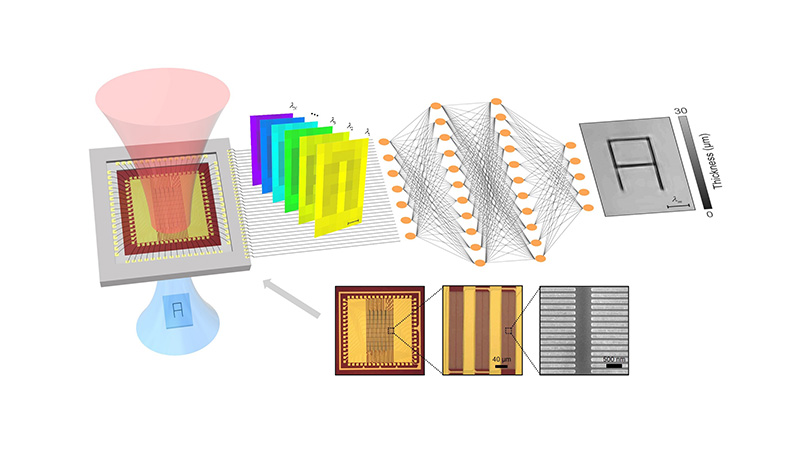UCLA Engineers Develop Terahertz Imaging System Capable of Capturing Real-Time, 3D Multi-Spectral Images for the First Time

Terahertz Electronics Laboratory/UCLA
Illustration of a new focal-plane array able to capture multispectral terahertz images in real time, aided by a trained neural network to enhance the resolution
Terahertz waves can penetrate opaque materials and provide unique spectral signatures of various chemicals, but their adoption for real-world applications has been limited by the slow speed, large size, high cost and complexity of terahertz imaging systems. The problem arises from the lack of suitable focal-plane array detectors, components that contain radiation detectors used by the imaging system.
A research team led by Mona Jarrahi, and Aydogan Ozcan, both electrical and computer engineering professors at the UCLA Samueli School of Engineering, has invented a new terahertz focal-plane array to solve this problem. By eliminating the need for raster scanning, which captures and displays an image point by point, the research team is able to expedite imaging more than 1000 times faster than current systems. The new array constitutes the first known terahertz imaging system that is fast enough to capture videos and provide real-time, 3D multi-spectral images while maintaining a high signal-to-noise ratio.
Published in Nature Photonics, the UCLA study describes the new focal-plane array, which involves fitting 283,500 nanoantennas in a space smaller than the size of a typical sesame seed. The array is capable of providing spatial amplitude and phase distributions, as well as an imaged object’s temporal and spectral data directly, thereby bypassing the need for raster scanning. The team also utilized a machine learning-trained neural network to enhance the resolution of the captured images in real time.
“Terahertz imaging can help us see things we couldn’t detect using other processes or technologies,” said Jarrahi, who holds the Northrop Grumman Chair in Electrical Engineering and leads the Terahertz Electronics Laboratory at UCLA Samueli. “With this focal-plane array, we have unlocked new possibilities to use terahertz imaging for real-time, high-throughput scanning and detection in a way that wasn’t possible before.”
Prior attempts to create faster terahertz imaging systems have resulted in low signal-to-noise ratios, making it difficult for researchers to obtain clean images. The systems were also bulky and expensive. Using the new focal-plane array and its accompanying neural network, the research team demonstrated the system’s ability to image 3D patterns etched in silicon with more than 1,000 pixels.
“With this focal-plane array, we have unlocked new possibilities to use terahertz imaging for real-time, high-throughput scanning and detection in a way that wasn’t possible before,” said Mona Jarrahi.
The relatively low energy of terahertz photons and their ability to penetrate through many opaque and nonconductive materials make terahertz radiation promising for a variety of applications. These include medical imaging, security screening and pharmaceutical or agricultural product inspection.
The study was funded by the U.S. Department of Energy, the U.S. Office of Naval Research, and the Institution of Engineering and Technology. Jarrahi and Ozcan are both members of the California NanoSystems Institute at UCLA, where Ozcan serves as the associate director of entrepreneurship, industry and academic exchange. Ozcan, who holds UCLA’s Volgenau Chair for Engineering Innovation and leads the Ozcan Research Group, also has faculty appointments in the Department of Bioengineering and the David Geffen School of Medicine at UCLA.
The technology is being commercialized by Lookin Inc., a startup spun off from Jarrahi’s research group. The company was co-founded by Jarrahi and Nezih Tolga Yardimci, a postdoctoral researcher and member of her research group. Yardimci is an author of the paper and serves as Lookin’s CEO and chief technology officer.
Other authors of the paper are UCLA Samueli postdoctoral researcher Xurong Li, graduate student Deniz Mengu, alumnus Deniz Turan and Ali Charkhesht — a principal engineer at Lookin. All but Charkhesht are current or former members of Jarrahi’s and Ozcan’s research labs at UCLA.
